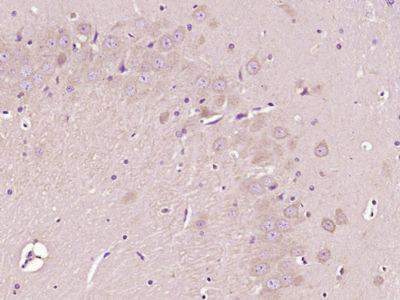产品货号 : mlR15445
英文名称 : HECT E3 ubiquitin ligase
中文名称 : HECT E3泛素链接酶抗体
别 名 : CEB1; CEBP1; Cyclin E binding protein 1; Cyclin-E-binding protein 1; E3 ISG15--protein ligase HERC5; HECT domain and RCC1 like domain containing protein 5; HECT domain and RCC1-like domain-containing protein 5; Hect domain and RLD 5; HECT E3 ubiquitin ligase; HERC5; HERC5_HUMAN; Herc6.
研究领域 : 细胞生物 免疫学 染色质和核信号 表观遗传学
抗体来源 : Rabbit
克隆类型 : Polyclonal
交叉反应 : Human, Rat,
产品应用 : ELISA=1:500-1000 IHC-P=1:400-800 IHC-F=1:400-800 ICC=1:100-500 IF=1:100-500 (石蜡切片需做抗原修复)
not yet tested in other applications.
optimal dilutions/concentrations should be determined by the end user.
分 子 量 : 117kDa
细胞定位 : 细胞浆
性 状 : Lyophilized or Liquid
浓 度 : 1mg/ml
免 疫 原 : KLH conjugated synthetic peptide derived from human HECT E3 ubiquitin ligase:1-100/1024
亚 型 : IgG
纯化方法 : affinity purified by Protein A
储 存 液 : 0.01M TBS(pH7.4) with 1% BSA, 0.03% Proclin300 and 50% Glycerol.
保存条件 : Store at -20 °C for one year. Avoid repeated freeze/thaw cycles. The lyophilized antibody is stable at room temperature for at least one month and for greater than a year when kept at -20°C. When reconstituted in sterile pH 7.4 0.01M PBS or diluent of antibody the antibody is stable for at least two weeks at 2-4 °C.
PubMed : PubMed
产品介绍 : HECT E3 ubiquitin ligase is a member of the HERC family of ubiquitin ligases and encodes a protein with a HECT domain and five RCC1 repeats. Pro-inflammatory cytokines upregulate expression of this gene in endothelial cells. The protein localizes to the cytoplasm and perinuclear region and functions as an interferon-induced E3 protein ligase that mediates ISGylation of protein targets. The gene lies in a cluster of HERC family genes on chromosome 4.
Function:
Major E3 ligase for ISG15 conjugation. Acts as a positive regulator of innate antiviral response in cells induced by interferon. Makes part of the ISGylation machinery that recognizes target proteins in a broad and relatively non-specific manner. Catalyzes ISGylation of IRF3 which results in sustained activation, it attenuates IRF3-PIN1 interaction, which antagonizes IRF3 ubiquitination and degradation, and boosts the antiviral response. Catalyzes ISGylation of influenza A viral NS1 which attenuates virulence; ISGylated NS1 fails to form homodimers and thus to interact with its RNA targets. Catalyzes ISGylation of papillomavirus type 16 L1 protein which results in dominant-negative effect on virus infectivity. Physically associated with polyribosomes, broadly modifies newly synthesized proteins in a cotranslational manner. In an interferon-stimulated cell, newly translated viral proteins are primary targets of ISG15.
Subunit:
Binds to CCNA1, CCNB1, CCND1 and CCNE1. Interacts with UBE2L6. Interacts with IRF3, this interaction is marginal in resting cells but enhanced upon viral infection.
Subcellular Location:
Cytoplasm, perinuclear region. Note=Associated with the polyribosomes, probably via the 60S subunit.
Tissue Specificity:
Expressed in testis and to a lesser degree in brain, ovary and placenta. Found in most tissues at low levels.
Post-translational modifications:
ISGylated (Probable).
Similarity:
Contains 1 HECT (E6AP-type E3 ubiquitin-protein ligase) domain.
Contains 5 RCC1 repeats.
SWISS:
Q9UII4
Gene ID:
51191
Important Note:
This product as supplied is intended for research use only, not for use in human, therapeutic or diagnostic applications.
产品图片












